👇 Take this lesson with you! 👇
Welcome to Part 2 of my lesson on Basic English Grammar for beginners.
Read PART 1 of this article here.
In Part 2, we will look at Adjectives, Pronouns, Prepositions and Conjunctions.
Hold tight, here we go.
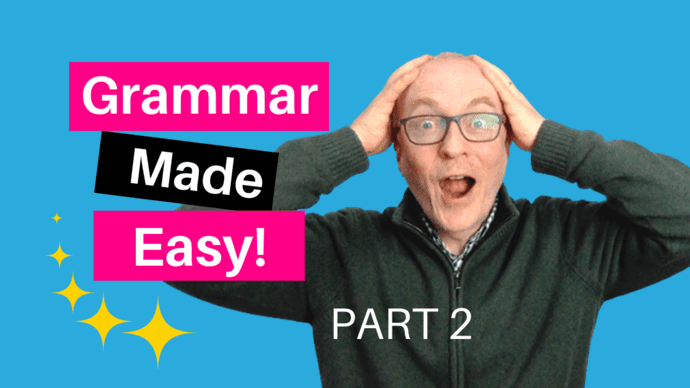
Table of Contents
English grammar: ADJECTIVES
So, let’s begin with adjectives.
Basically, adjectives describe nouns. Simple as that. For example,
An interesting book
A delicious chocolate
A refreshing drink
The adjective comes before the noun
A refreshing drink
ARTICLE + ADJECTIVE + NOUN
Adjectives are so useful in IELTS Speaking because they enrich your language and make your descriptions much more interesting.
When learning adjectives I strongly recommend you also learn the antonyms, if possible. An antonym is a word with the opposite meaning.
For example, the antonym of big is small.
Antonyms of adjectives will help build up your range of vocabulary very quickly.
What I do is, I make a note of the new adjective and antonym and try to make simple phrases using them, speaking them out loud. I make phrases that are true for me, so they are easier to remember.
For example,
I have a big kitchen in a small flat!
It’s true, I wish I could buy a bigger flat!
Now, another important thing to know about adjectives, is that we can use adverbs to describe adjectives; adverbs such as,
- Really
- Absolutely
- Totally
- Completely
This is a really exciting book
ADVERB + ADJECTIVE + NOUN
That was an absolutely delicious chocolate
ADVERB + ADJECTIVE + NOUN
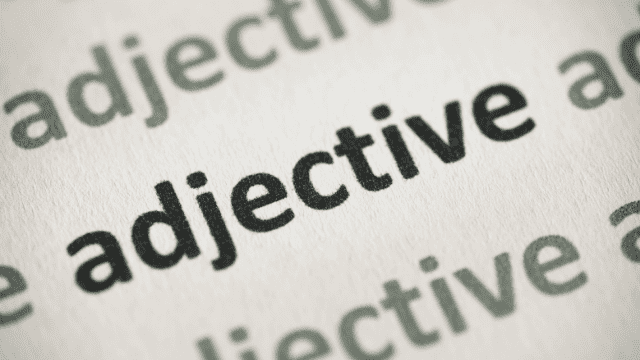
PRONOUNS in english
As you might be able to guess, pronouns replace nouns (people, places, things) or a noun phrase.
We use them in order to avoid too much repetition. For example, the first two sentences below are fine, but the repetition of ‘your car’ doesn’t sound very natural. It would be better to replace it with ‘it’
Your car is lovely. She likes your car.
Your car is lovely. She likes it.
At the same time, as you can see, this use of pronouns enables us to reference things, places, or people we have previously mentioned.
There are 3 main kinds of pronouns
1. Subject Pronouns
A subject pronoun replaces a noun that is the subject of a phrase. A ‘subject’ of a phrase is just the person (place or thing) doing something.
In the example, below, ‘Jack’ is the subject (who is eating) and is replaced by ‘he’.
Jack ate the chocolate HE ate the chocolate
Here is a list of the subject pronouns
- I
- YOU
- HE / SHE / IT
- YOU (plural)
- WE
- THEY
2. Object Pronouns
An object pronoun replaces a noun that is the object of a phrase. An ‘object’ of a phrase is just the person (place or thing) that is the object of the action.
Look at this example,
Anny likes Keith
Here, ‘Keith’ is the object (who is liked by Anny) and we can replace ‘Keith’ with the object pronoun ‘him’.
Anny likes HIM
Here is a list of the object pronouns
- ME
- YOU
- HIM / HER / IT
- US
- YOU
- THEM
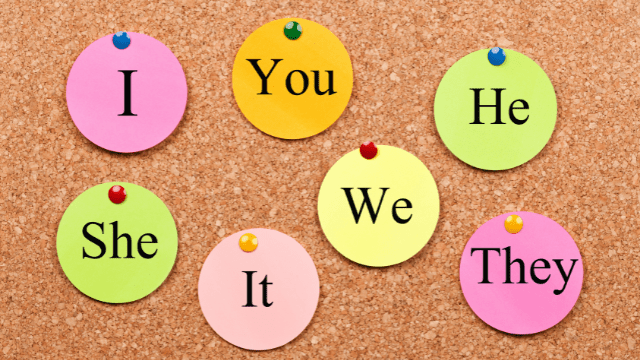
3. Possessive Pronouns
A possessive pronoun replaces a noun that belongs to someone, (the possessive adjective + noun). For example,
This is my hat
POSSESSIVE ADJECTIVE + NOUN
In the example below, ‘my hat’ is the noun (that belongs to me) and in the second sentence is replaced by ‘mine’ (The possessive pronoun).
I think this is my hat. Yes, I am sure it’s mine!
Here are the possessive pronouns
- MINE
- YOURS
- HIS
- HERS
- OURS
- THEIRS
NOTICE: When names are used to describe possession, we use an apostrophe before the ’s’.
For example,
That is Keith’s hat.
However, possessive pronouns do not have an apostrophe before the ’s’. For example, we do not say ‘It’s your’s hat’. No, we say ‘it’s YOUR hat’.
PREPOSITIONS in english
Let’s move on and look at prepositions in English. This is one of the most important aspects of basic English grammar for beginners.
Since prepositions have many functions, and also often correspond to several different prepositions in other languages, I think the best approach here is to go step by step.
Here, we will look at 3 different prepositions that are actually also related.
Try to avoid translating prepositions, this often leads to mistakes.
Instead, I think it’s also useful to get the ‘feeling’ of how we use prepositions in English.
There is a very useful book for advanced learners that looks at this ‘feeling’ of prepositions in more detail. You can get a feel for this (ha ha 😄 ) by reading an excerpt via the link below
Here, I will look at the following 3 prepositions and what is the general feeling they create when we use them in English.
- At
- On
- In
How to use the preposition 'at'
1) ’AT’ used to give a feeling of a specific point or time
Examples:
I live at 221 Baker Street
I get up at 6 o’clock
2) ‘AT’ used to give a feeling of a Space or Bubble
If I say, ‘I am at home’, then we don’t know exactly where I am in the house. I might be in the kitchen or in the bathroom. So we use AT to give an idea of being in a wider space or you can also imagine the idea of being in a bubble. The house being the bubble.
See similar examples below.
I am at home
I am at work
She is at the beach
We are at the cinema
He is at the shops
How to use the preposition 'on'
1) ON used to give a feeling of touching a surface
Examples :
The cup is on the table
The picture is on the wall
I live on Baker Street
In the last example, we have the idea of the whole street being a surface and you live on one part of that surface.
2) ON used to give a feeling of being on a platform
Examples:
I’m on the Internet
She’s on the phone
I’m on Facebook
I saw a film on Netflix
3) ON used to give a feeling of being on a platform time
We use ON with days of the week.
If you can imagine a day being elevated (on a platform) higher than other days of the week, then this is one way to remember the use of ON for days.
Examples:
I always go swimming on Mondays
He came on Tuesday
I have an appointment on the 5th Jan
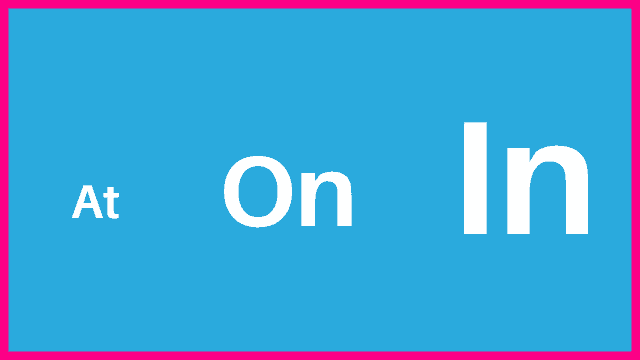
How to use the preposition 'in'
1) ‘IN’ used to give a feeling of being contained in a place
Examples:
The present was in a box I live in ManchesterGet in the car!
If I say, ‘I live in Spain’ we can imagine Spain as the container and I am inside that container. Likewise with a city or even a neighbourhood.
2) ‘IN’ used to give a feeling of being contained in time
Example:
I will visit you in July
In the example above, it helps to imagine the month as containing lots of days, and I will visit you on one of those days but I don’t say which one.
The same idea can apply with seasons and years.
Examples:
I will go in summer I went there in 2021
There is a connection between these 3 prepositions.
If you look at the examples below, you can see how the time or distance gets bigger and bigger, as we move form AT to ON and then to IN.
At 6 o’clock, on Monday, in July At 221 Baker Street, on Baker Street, in London
If it helps, you can also imagine this graphically like this.
Basic grammar: CONJUNCTIONS
Conjunctions are simple words that join two words, phrases or clauses.
They help show the relationship between the two.
Most Common Spoken Conjunctions
- and
- or
- but
- so
- before
- after
- because
- as soon as
In the example below, we have two sentences, and we can join them with a conjunction to make our English flow more naturally.
He eats a lot. He is fat.
Examples with conjunctions
He eats a lot so he is fat
He eats a lot because he is fat
He eats a lot and he is fat
In IELTS Speaking conjunctions are invaluable because they are a simple way to create complex sentences.
We can build one clause on top of another and connect them with conjunctions.
You should also know that the most commonly used conjunctions are the simple ones mentioned above.
Conclusion
In Part 1 and Part 2 of this lesson on Basic English Grammar, we have seen 8 of the most important parts of speech.
We have seen the most important features of each and how to use them.
Remember, my advice is use grammar rules as a reference, don’t start learning English with grammar – that can be very boring and not helpful.
Start learning English by
- Listening
- Loving
- Repeating
Then you can check the grammar rules, and of course, then, you need to practice.
You can practice with others or on your own. Both ways are fine.
I am keen to help you with your grammar, so leave a comment below and tell me more about other areas of grammar you would like help with.
Thanks for reading Part 2 of Basic English Grammar.
Do leave a comment below if you have any questions.
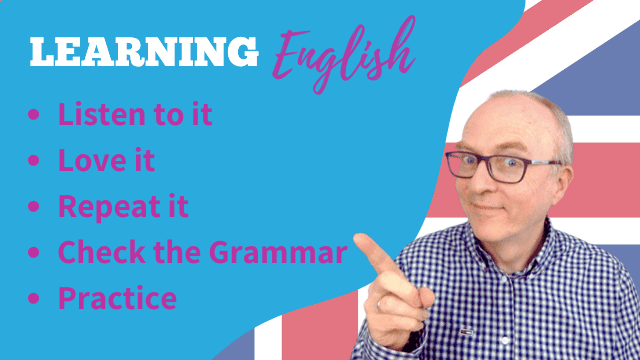

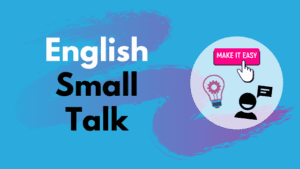
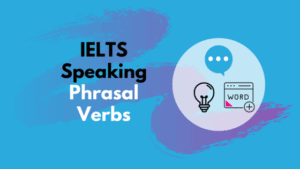
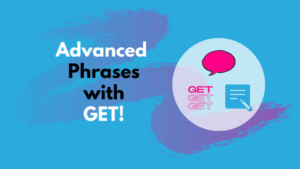
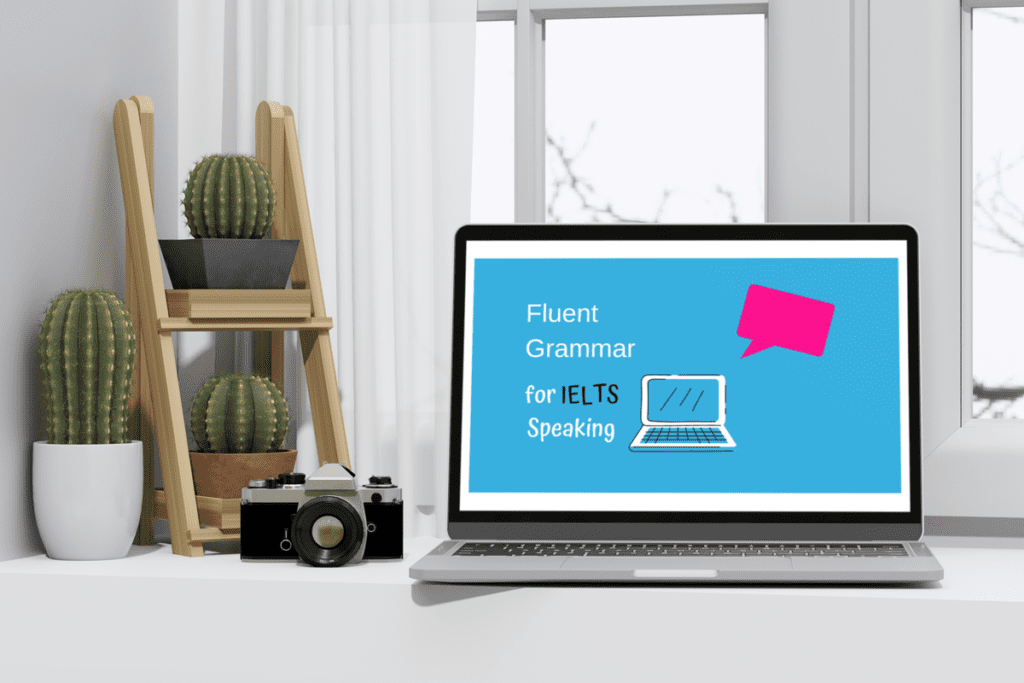
10 thoughts on “Learn Basic English Grammar: Beginners – Part 2”
I just love it. Great Job<3
Thank you so much!
Helpful grammar
Glad you liked it!
What is the difference between the YouTube lessons and paid lessons?
Massive Thanks Sir
Massive welcome!
thank you
You are welcome!
Pingback: Learn Basic English Grammar: Beginners – Part 2 – IELTS TEST – how to prepare?